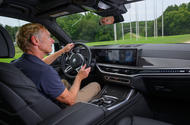BMW’s attempt to charge for already installed heated seats shows there’s a balance to be struck
One of the more unpopular moves in the automotive industry in recent times was BMW’s attempt to charge customers to ‘activate’ hardware options that were already fitted in their cars, such as heated seats.
“People feel that they paid double – which was actually not true, but perception is reality, I always say,” BMW sales and marketing chief Pieter Nota told Autocar last month. “So that was the reason we stopped that.”
Instead, the firm will focus on charging for software upgrades, which BMW has also experienced bad press with before when it tried to charge £295 to access the in-built Apple CarPlay functionality, a move it also reversed.
This time, Nota said the likes of “driving assistance and parking assistance” features will be available for buyers to upgrade to, something Nota says “customers are used to paying for in other areas”.
We’ll see, but car makers sense an opportunity to make money on cars long after they’ve left forecourts and potentially through multiple owners, and they’re not going to give this opportunity up easily.
“It will play a role,” Volkswagen boss Thomas Schäfer told me at the recent Munich motor show when asked if this was an area VW was looking into also off the back of BMW’s recent moves, with a working committee looking at its potential now. “The question is always: what are customers really prepared to pay for? That varies from model to model and brand to brand.
“What BMW did I think the customer would expect [the chargeable options you could activate] to be in the vehicle, not to unlock it with additional money.
“You need to find things that customers are really happy with. There’s definitely revenue potential in it but don’t try and sell them Spotify access or something. It’s a tight balance between additional value that you’re happy to pay for and not.”
It is indeed a balancing act and, at the moment, it feels a bit of a wild west in who’s offering what, for how much and what it’s called. I’ve spent some time in a Range Rover Sport recently, and when exiting the vehicle one day, it offered me a software upgrade through an over-the-air update that had a long list of improvements that would be made to the car. This was welcomed.
At the other end of the scale, there is BMW’s approach with features on demand, something also done by Polestar. My colleague Matt Prior ran a Polestar 2 last year and was offered the chance to give the car an extra 67bhp and 15lb ft of torque in a £1000 performance upgrade, also done remotely via a software patch.
It all feels quite murky and subjective: should you be paying for extra performance in a car, but not a better infotainment system? Where does the value come from and who sets the price? Does it transfer ownership when the car is sold and what does that then mean for residual values if not?
Software is one of those intangible assets that is hard enough to price on its own, but when it’s put alongside a piece of hardware – a car – costing tens of thousands of pounds wearing the badge of a brand that has values and perceptions attached to it, then that job gets harder still. That software better be faultless to operate as well, should car makers charge after the vehicle’s original purchase.
Rather than charging for constant upgrades and new features, perhaps the business case could be the opposite and a brand could win by throwing it all in for free. When pricing gets involved, so does competition.
Schäfer’s committee, like others that will be looking at this in the industry, have their work cut out to convince the court of public opinion if this is ever going to take off.
Source: Autocar
